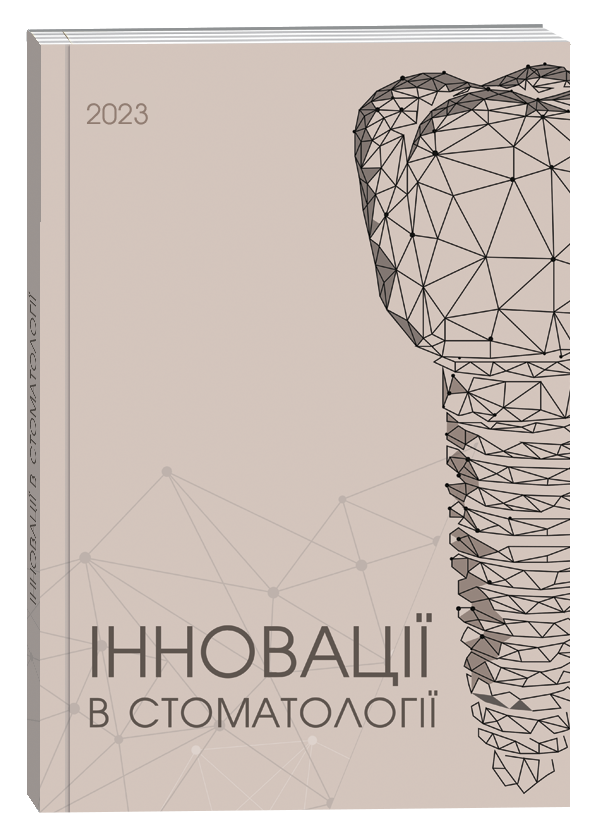QUALITY OF LIFE OF ADULTS WITH PERIODONTAL DISEASES IN THE PRESENCE OF DENTAL DEFORMITIES
DOI:
https://doi.org/10.35220/2523-420X/2023.4.9Keywords:
quality of life, oral health, periodontal disease, orthodontic treatment, gingival margin, adults, dentoalveolar anomaliesAbstract
Over the past two decades, more and more attention has been paid to the dentoalveolar aesthetics of children and adults, while the need for orthodontic treatment is growing. It is reported that the main motivating factor in this group of patients is the desire to improve the appearance of the bite and face. Particular attention should be paid to the periodontal status of orthodontic patients, as they most likely already have periodontitis. Epidemiological studies show that mucosal diseases are widespread, with acute periodontitis affecting a small percentage of the population, about 8%–13%. Periodontal diseases are more common in patients with dentoalveolar anomalies and abnormalities of individual teeth, especially crowding and rotation of the teeth, position of incisors, canines, maxillary and mandibular molars, supraocclusion and infraocclusion. Therefore, it is very important to identify patients who are at risk and who have more pronounced diseases of the oral mucosa. A classic patient with periodontitis usually has protrusion of the frontal area of the upper jaw, gaps, twists of the teeth, and supraocclusion. These changes in the position of the teeth can complicate the long-term care associated with plaque cleaning, as it reduces the control over the cleaning of plaque, as well as impairs the aesthetics and function of the dentition. The purpose of this article is to provide an update of the interrelationship between periodontics and orthodontics in adults, the synergy of the elements of which is important for the development of the life of the adult, who сontacts for the specialized dental assistance. Specific areas reviewed are the reaction of periodontal tissue to orthodontic forces, the influence of tooth movement on the periodontium, the effect of orthodontic treatment on the periodontium is discussed.
References
Proffit, W., Fields, H.W. Jr., & Moray, L.J. (2008). Prevalence of malocclusion and orthodontic treatment need in the United States: estimates from the NHANES-III survey. Int J Adult Orthod Orthognath Surg, 13, 97–106.
Proffit, W. (2000). Special considerations in comprehensive treatment for adults. In: W. Proffit, H.W. & Fields, [Ed]. Contemporary orthodontics. 3rd ed. St. Louis: Mosby.
Carvalho, C.V., Saraiva, L., Bauer, F.P.F., Kimura, R.Y., Souto, M.L.S., Bernardo, C.C., Pannuti, C.M., Romito, G.A., & Pustiglioni, F.E. (2018). Orthodontic treatment in patients with aggressive periodontitis. Am J Orthod Dentofacial Orthop. 153(4), 550–557. doi: 10.1016/j.ajodo.2017.08.018.
Zasčiurinskienė, E, Basevičienė, N, Lindsten, R, Slotte, C, Jansson, H, & Bjerklin, K. (2018). Orthodontic treatment simultaneous to or after periodontal cause-related treatment in periodontitis susceptible patients. Part I: Clinical outcome. A randomized clinical trial. J Clin Periodontol., 45(2), 213–224. doi: 10.1111/jcpe.12835.
Cárcamo-España, V, Cuesta Reyes N, Flores Saldivar, P, Chimenos-Küstner, E, Estrugo Devesa, A, & López-López J. (2022). Compromised Teeth Preserve or Extract: A Review of the Literature. J Clin Med., 8, 11(18), 5301 doi: 10.3390/jcm11185301.
Moeini, N, Sabri, H, Galindo-Fernandez, P, Mirmohamadsadeghi, H, & Valian, N.K. (2023). Periodontal status following orthodontic mini-screw insertion: A prospective clinical split-mouth study. Clin Exp Dent Res., 9(4), 596–605 doi: 10.1002/cre2.757
Cao, T., Xu, L., Shi, J., & Zhou, Y. (2015). Combined orthodontic-periodontal treatment in periodontal patients with anteriorly displaced incisors. Am J Orthod Dentofacial Orthop., 148(5), 805–13 doi: 10.1016/j.ajodo.2015.05.026
Jonsson, T., Karlsson, K.O., Ragnarsson, B., & Magnusson, T.E. (2010). Long-term development of malocclusion traits in orthodontically treated and untreated subjects. Am J Orthod Dentofacial Orthop., 138(3), 277–84 doi: 10.1016/j.ajodo.2009.08.027
Kirschneck, C., Fanghänel, J., Wahlmann, U., Wolf, M., Roldán, J.C., & Proff, P. (2017). Interactive effects of periodontitis and orthodontic tooth movement on dental root resorption, tooth movement velocity and alveolar bone loss in a rat model. Ann Anat., 210, 32–43 doi: 10.1016/j.aanat.2016.10.004.
Dersot, J.M. (2012). Gingival recession and adult orthodontics: a clinical evidence-based treatment proposal. Int Orthod., 10(1), 29–42. English, French. doi: 10.1016/j.ortho.2011.09.013.
Grenga, C., Guarnieri, R., Grenga, V., Bovi, M., Bertoldo, S., Galluccio, G., Di Giorgio, R., & Barbato, E. (2021). Periodontal evaluation of palatally impacted maxillary canines treated by closed approach with ultrasonic surgery and orthodontic treatment: a retrospective pilot study. Sci Rep., 2, 11(1), 2843 doi: 10.1038/s41598-021-82510-y.








